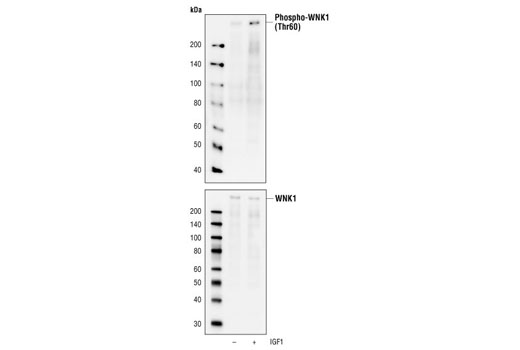WB
H
Endogenous
230
Rabbit
#Q9H4A3
65125
Product Information
Product Usage Information
| Application | Dilution |
|---|---|
| Western Blotting | 1:1000 |
Storage
Specificity / Sensitivity
Species Reactivity:
Human
Species predicted to react based on 100% sequence homology
The antigen sequence used to produce this antibody shares
100% sequence homology with the species listed here, but
reactivity has not been tested or confirmed to work by CST.
Use of this product with these species is not covered under
our
Product Performance Guarantee.
Mouse, Rat
Source / Purification
Polyclonal antibodies are produced by immunizing animals with a synthetic phosphopeptide corresonding a region surrounding Thr60 of human WNK1. Antibodies are purified by protein A and peptide affinity chromatography.
Background
The WNK [with no lysine (K)] family of serine/threonine kinases is characterized by having a cysteine in place of lysine in subdomain II of its kinase activation domain (1,2). The lysine necessary for phosphoryl transfer is located in an atypical position in the catalytic domain. Four WNK family members have been identified in humans (WNK1-4) and have been implicated in regulating ion permeability (3). Mutations in the WNK1 and WNK4 genes in humans cause pseudohypoaldosteronism type II (PHAII), an autosomal dominant disorder leading to hypertension, hyperkalemia, and renal tubular acidosis (4). WNK4 is specifically expressed in the kidney, whereas WNK1 has a wider distribution but is predominantly expressed in polarized epithelia (1-3). Heterozygous mutations in WNK1 in mice result in a significant decrease in blood pressure, while homozygous mutations are embryonic lethal (5). WNK1 is phosphorylated by Akt at Thr60 (6). In addition, WNK1 may be autophosphorylated at Ser382 in the activation loop, and this is thought to be required for its kinase activity (7).
- Veríssimo, F. and Jordan, P. (2001) Oncogene 20, 5562-9.
- Xu, B. et al. (2000) J Biol Chem 275, 16795-801.
- Choate, K.A. et al. (2003) Proc Natl Acad Sci U S A 100, 663-8.
- Wilson, F.H. et al. (2001) Science 293, 1107-12.
- Zambrowicz, B.P. et al. (2003) Proc Natl Acad Sci U S A 100, 14109-14.
- Vitari, A.C. et al. (2004) Biochem J 378, 257-68.
- Xu, B.E. et al. (2002) J Biol Chem 277, 48456-62.
Species Reactivity
Species reactivity is determined by testing in at least one approved application (e.g., western blot).
Western Blot Buffer
IMPORTANT: For western blots, incubate membrane with diluted primary antibody in 5% w/v BSA, 1X TBS, 0.1% Tween® 20 at 4°C with gentle shaking, overnight.
Applications Key
WB: Western Blotting
Cross-Reactivity Key
H: human M: mouse R: rat Hm: hamster Mk: monkey Vir: virus Mi: mink C: chicken Dm: D. melanogaster X: Xenopus Z: zebrafish B: bovine Dg: dog Pg: pig Sc: S. cerevisiae Ce: C. elegans Hr: horse GP: Guinea Pig Rab: rabbit All: all species expected
Trademarks and Patents
Limited Uses
Except as otherwise expressly agreed in a writing signed by a legally authorized representative of CST, the following terms apply to Products provided by CST, its affiliates or its distributors. Any Customer's terms and conditions that are in addition to, or different from, those contained herein, unless separately accepted in writing by a legally authorized representative of CST, are rejected and are of no force or effect.
Products are labeled with For Research Use Only or a similar labeling statement and have not been approved, cleared, or licensed by the FDA or other regulatory foreign or domestic entity, for any purpose. Customer shall not use any Product for any diagnostic or therapeutic purpose, or otherwise in any manner that conflicts with its labeling statement. Products sold or licensed by CST are provided for Customer as the end-user and solely for research and development uses. Any use of Product for diagnostic, prophylactic or therapeutic purposes, or any purchase of Product for resale (alone or as a component) or other commercial purpose, requires a separate license from CST. Customer shall (a) not sell, license, loan, donate or otherwise transfer or make available any Product to any third party, whether alone or in combination with other materials, or use the Products to manufacture any commercial products, (b) not copy, modify, reverse engineer, decompile, disassemble or otherwise attempt to discover the underlying structure or technology of the Products, or use the Products for the purpose of developing any products or services that would compete with CST products or services, (c) not alter or remove from the Products any trademarks, trade names, logos, patent or copyright notices or markings, (d) use the Products solely in accordance with CST Product Terms of Sale and any applicable documentation, and (e) comply with any license, terms of service or similar agreement with respect to any third party products or services used by Customer in connection with the Products.
